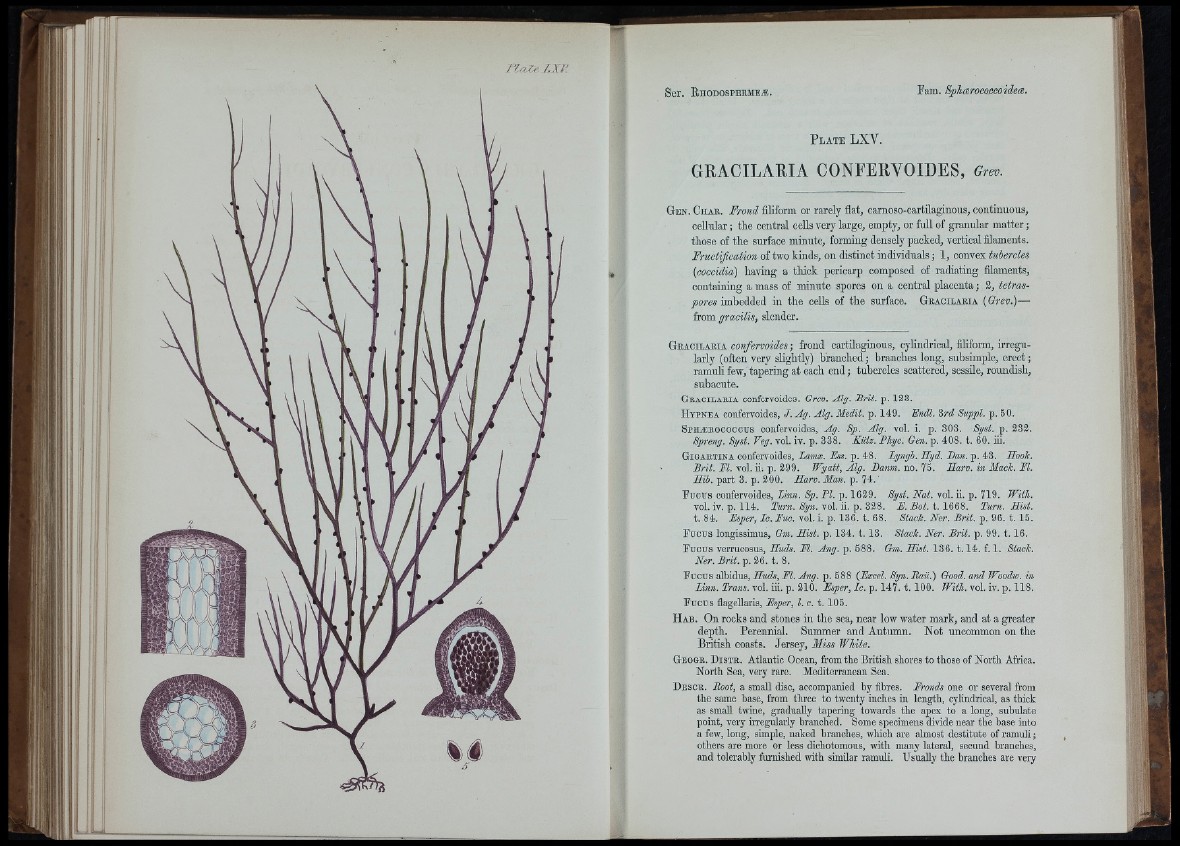
■'i i J I. i
P l a t e LXV.
GRACILARIA CONLLRVOIDLS, Grev.
G e n . C h a e . Frond filiform or rarely flat, carnoso-cartilaginous, continuous,
cellular; the central ceUs very large, empty, or full of granular matter;
those of the surface minute, forming densely packed, vertical fllaments.
Fructification of two kinds, on distinct individuals; 1, convex tubercles
(coccidia) having a thick pericarp composed of radiating filaments,
containing a mass of minute spores on a central placenta; 3, tetraspores
imbedded in the ceUs of the surface. G e a c i l a e i a (Grev.)—
from gracilis, slender.
G e a c i l a e i a confervoides; frond cartilaginous, cylindrical, filiform, irregularly
(often very slightly) branched; branches long, subsimple, erect;
ramuli few, tapering at each end; tubercles scattered, sessile, roundish,
subaoute.
G e a c il a e ia co n ferv o id es. Grev. Alg. Brit. p . 1 2 3 .
H y p n e a eonfervoides, J. Ag. Alg. Medit. p. 149. Endl. 3rd Suppl. p. 50.
Sph a ieo o o o c u s confervoides, Ag. Sp. Alg. vol. i. p. 303. Sgst. p. 332.
Spreng. Syst. Veg. vol. iv. p. 338. Kiitz. PJiyo. Gen. p. 408. t. 60. iii.
G ig a e t in a confervoides, Lamx. Ess. p. 48. Lyngh. Hyd. Ban. p. 43. Hook.
B rit. El. vol. ii. p. 299. Wyatt, Alg. Banm. no. 75. Harv. in Mack. El.
Hib. part 3. p. 200. Harv. Man. p. 74.
F u o u s confervoides, Linn. Sp. PI. p. 1629. Syst. Nat. vol. ii. p. 719. With.
vol. iv. p. 114. Turn. Syn. vol. ii. p. 328. E. Bot. t. 1668. Turn. Hist.
t . 84. Esper, Ic. Euo. vol. i. p. 136. t. 68. Stack. Ner. Brit. p. 96. 1 .15.
F o cu s longissimus, Gm. Hist. p. 134. t. 13. Stack. Ner. Brit. p. 99. 1 .16.
F u cu s verrucosus, Huds. El. Ang. p. 588. Gm. Hist. 136. 1 .14. f. 1. Stacie.
Ner. Brit. p. 26. t. 8 .
F u cu s albidus, Huds, El. Ang. p. 588 {Excel. Syn. Ban!) Good, and Woodw. in
Linn. Trans, vol. iii. p. 210. Esper, Ic. p. 147. t. 100. With. vol. iv. p. 118.
F u cu s flagellaris, Esper, I. c. t, 105.
H a b . On rooks and stones in the sea, near low water mark, and at a greater
depth. Perennial. Summer and Autumn. Not uncommon on the
British coasts. Jersey, Miss White.
G e o g e . D i s t e . Atlantic Ocean, from the British shores to those of North Africa.
North Sea, very rare. Mediterranean Sea.
D e s c e . Boot, a smaU disc, accompanied by fibres. Fronds one or several from
the same base, from three to twenty inches in length, cylindrical, as thick
as small twine, gradually tapering towai’ds the apex to a long, subulate
point, very irregularly branched. Some specimens divide near the base into
a few, long, simple, naked branches, which are almost destitute of ramuli;
others are more or less dichotomous, with many lateral, secund branches,
and tolerably furnished with similar ramuli. UsuaUy the branches are very